|
Organic
products from your balcony… to your table
(By Andreas Barboutsis)
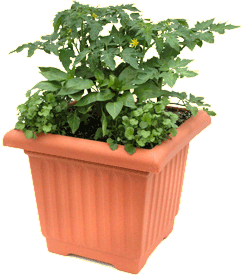 Every
spring the balconies of many apartment buildings resemble hanging gardens,
lending the beauty of their blooms to the overall aspect of the city: Wisterias
and bougainvilleas climb up to the height of several stories to ornament grey
blank walls, while in the constricted open spaces between the tall buildings,
shrubs and trees flower thanks to the abundant sunlight and our scant
ministrations. Every
spring the balconies of many apartment buildings resemble hanging gardens,
lending the beauty of their blooms to the overall aspect of the city: Wisterias
and bougainvilleas climb up to the height of several stories to ornament grey
blank walls, while in the constricted open spaces between the tall buildings,
shrubs and trees flower thanks to the abundant sunlight and our scant
ministrations.
Yearly
however the number of rooftop “kitchen” gardens increases ¯ those small
plots covering a few square metres, filled with all kinds of vegetables ¯ as
well as the number of potted fruit-trees on verandas and the array of aromatic
herbs on kitchen window-sills.
This
trend is not new and certainly it is not a Greek invention. It has been a by-product of urban growth the world
over, ever since the apartment buildings
swallowed up the detached family homes with their surrounding modest gardens.
Most Western European countries however have taken in the past decades the trend
of the “city” garden one step further, introducing the system of
“shared” gardens with wonderful results. These are in fact state or
municipal owned plots of land which are parcelled out for a nominal rent to
families eager to cultivate vegetables and fruits for their own consumption on
their allotted patches.
Also,
throughout the Western world, various “urban self-sufficiency” projects have
been put into effect, aimed at popularising the concept of food production
within the city limits. In many cases their implementation has been proved quite
successful, which is very encouraging. One of the most impressive examples is
that of
Vancouver
in
Canada
: under climatic conditions that are far less favourable than
those prevailing at
Athens
, about half the households there produce part of the food
they are consuming.
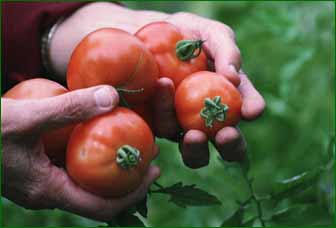 Furthermore,
the trend to create vegetable gardens at home has acquired additional impetus
ever since we have started worrying about the quality of the farm products we
buy at the market. Furthermore,
the trend to create vegetable gardens at home has acquired additional impetus
ever since we have started worrying about the quality of the farm products we
buy at the market.
The threat of genetically modified vegetables and fruits and the fear of
pesticides are a clear indication that it would be worth our while to devote a
modicum of our time to tend such a garden. Many are, as well, the benefits we
would accrue in the process, the topmost being that home-grown produce is far
more tasty than the market one, since it is harvested when fully ripe. On the
contrary, the fruits and vegetables we buy from the greengrocer or the
supermarket have been harvested quite unripe in order to survive the amount of
time necessary for their transportation to the market and that spend on the self, while
home-grown produce is consumed right away, without having been
preserved at various degrees of refrigeration for several weeks as it generally
does. Thus, our own fruits and vegetables provide us with the full benefit of
their vitamins and nutritional value, which play such an important role in
preserving our good health. Another benefit provided by the home garden ¯
apart from the fact that we re-establish a healthy relationship with nature and
the rotation of the seasons¯ is the deep satisfaction that we will certainly
feel when realizing that part of the food on our table has been produced by
ourselves. Additionally, gardening is an excellent stress-reducing occupation,
in which all the family can participate. In teaching our children the joys of
tilling the soil, of pruning and of harvesting we will be introducing them to a
harmless and rewarding pastime that will prove beneficial to the development of
their character.
Many
of us would have liked to establish a small vegetable garden at home, yet we
hesitate from fear that the polluted city air will poison our plants. However,
since the introduction of leadless gas, this danger has been diminished
considerably, to the point that ¯ according to the experts ¯ at a distance
of as less as some fifty metres from a highway it would be quite safe to
cultivate our chosen vegetables.
The basic rules of successful gardening:
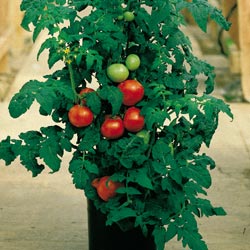 There
are a few basic rules you would have to follow for your garden to flourish, even
if your gardening experience is practically nil. There
are a few basic rules you would have to follow for your garden to flourish, even
if your gardening experience is practically nil.
• The position where you will establish your vegetable patch: it
should be sheltered from strong winds and it should be receiving ample sunlight
for several hours.
• The soil should be fertile and with good drainage. Yet even
common clay soils can always be improved with the application of humus and
organic manure or compost.
• Watering should be done with great care, since not all vegetables
need the same amount of water.
• The seeds are a very important factor. At the nursery where
you will purchase your seeds or seedlings, you can inquire which of your
favourite vegetables are more likely to thrive in your area. It is worth the
effort to seek seeds from local varieties or to buy organically produced seeds
from specialized shops, in order to avoid hybrids. You should plant the seeds in
small pots filled with turf or in seed trays, at the appropriate season and
following the instructions on the seed-packet. You should take care to keep the
soil moist until the seedlings appear, after which it is usually sufficient to
water them once a day until such time as the seedlings have grown enough to be
transplanted to their permanent position.
• The number of plants you need should be carefully calculated
beforehand. For example, a family of four does not need more than a dozen of
tomato plants and ten cucumber plants in order to enjoy fresh, tasty salads
throughout the summer months. You should however sow one-and-a-half more seed
than the required quantity, in order to counter possible losses.
• Transplanting the seedlings: Whether you are going to transplant your
seedlings in pots, containers or in open ground depends mainly on the size the
particular plant is going to have when fully grown. The nursery from which you
have purchased your seeds or seedlings is well qualified to advise you on the
subject.
• Companion planting: Some plants get along well with other plants ¯
each grows better in the presence of the other ¯ and some do not. Tomatoes,
for example, thrive when grown alongside carrots or celery, but they cannot
stand the company of potatoes. Cucumber plants “adore” peas and onions, but
do not grow well near radishes.
• Feeding your plants is not a difficult task. The nutrients necessary
for the healthy grow of most plants are well known and there are many reliable
fertilizers available, or you can apply well-rotted manure ¯ the tried and
tested method of organic plant feeding.
• Plant pests. You can fight the pests that may afflict your plants by
natural and harmless methods, without resorting to commercial pesticides. The
all-consuming snails can be picked by hand off your plants, if you are to rise
very early a couple of days and search for them among the leaves, or you can
hunt them down at night with the aid of a flashlight. Also, spraying the plants
with garlic juice, or well-cooled water in which you have boiled substantial
quantities of various herbs, like wormwood or deadnettle, will keep at bay
aphids, thrips and red spider mites.
• You can find useful advice for all of the above in the gardening
books and guides to organic gardening that are available in most bookstores.
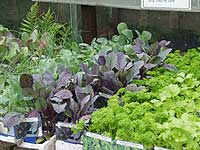 •
More advice: You will easily learn how to prune your plants and how to
protect your small kitchen garden from winter frosts. And, after you will
astonish your family and friends with your first spectacular successes, you may
decide that it is high time you should accumulate (in a special container) all
organic matter that is usually thrown away as garden and kitchen waste and
transform it into extremely valuable compost which will make your soil healthy
and provide your plants with nutrients and strength. You may even find both the
money and the few square metres necessary in order to install on your roof or on
your veranda one of those small “domestic” greenhouses that are now
available in Greece, in which you would be able to cultivate your vegetables ¯
or even exotic fruits ¯ the year round. Also, it would not be difficult, even
from the start, to build with bricks raised beds in your garden, so that all the
work you will have to do will be done without stooping and without backaches.
And later on, you may even decide to extend your activities and include animals
in your “farm”. Hens (without a rooster, which may annoy the neighbours) are
considered the easier domestic animals to breed and maintain. •
More advice: You will easily learn how to prune your plants and how to
protect your small kitchen garden from winter frosts. And, after you will
astonish your family and friends with your first spectacular successes, you may
decide that it is high time you should accumulate (in a special container) all
organic matter that is usually thrown away as garden and kitchen waste and
transform it into extremely valuable compost which will make your soil healthy
and provide your plants with nutrients and strength. You may even find both the
money and the few square metres necessary in order to install on your roof or on
your veranda one of those small “domestic” greenhouses that are now
available in Greece, in which you would be able to cultivate your vegetables ¯
or even exotic fruits ¯ the year round. Also, it would not be difficult, even
from the start, to build with bricks raised beds in your garden, so that all the
work you will have to do will be done without stooping and without backaches.
And later on, you may even decide to extend your activities and include animals
in your “farm”. Hens (without a rooster, which may annoy the neighbours) are
considered the easier domestic animals to breed and maintain.
• Conclusion: It is certain that you will not find it difficult to
discover appropriate solutions to anything you may come up against, aided solely
by the experience you will soon acquire and by your own creative imagination.
Members of your family, or friends with whom you share the same passion for life, may also lend a helping
hand.
A bounty to choose from:
The following list comprises of plants that are easy to cultivate and which,
usually, will reward you with large crops.
• Vegetables: tomato, cucumber, peppers, eggplant, marrow, onion, leek,
celery, carrot, radish, cabbage, lettuce, spinach, peas, beans.
• Fruits: strawberry, gooseberry, raspberry.
• Aromatic herbs: basil, rosemary, sage, mint, marjoram, oregano, thyme,
parsley, rocket, laurel.
• Fruit trees: fig, apple, pear, apricot, quince, cherry, lemon.
CROP
ROTATION AND SUCCESSION CROPPING
It is advisable to divide the space allotted for a vegetable garden into four
lots. On each lot you should grow different vegetables, so that in the next
planting season each vegetable will be planted on a different lot. This method
ensures better and larger crops, because on each planting season your plants, by
changing soil, avoid plant diseases and insect enemies that live in the soil and
affect the particular plants, while by changing site they find in the soil the
necessary nutrients that often differ for each kind of plant.
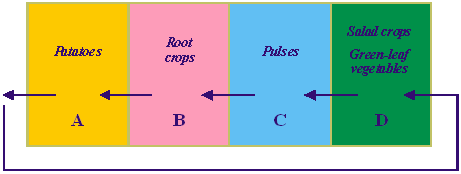
Succession
cropping
Conditional
upon the soil being rich in organic matter, lot A should be planted with
potatoes, lot B with root crops (turnips, beats, radishes), lot C with pulses
and lot D with salad crops or green-leaf vegetables. The cultivation of potatoes
results in keeping the soil loose and in reducing perennial weeds. On the other
hand, by using large quantities of manure or fertilizer for the benefit of the
potato crop, you are going to need less for the next three planting seasons,
until you come back to growing potatoes on lot A.
After
the potatoes have been harvested, lot A should be devoted to producing a root
crop (turnips, beets, radishes), which grow better on soil that has been
fertilized with manure for a previous crop. It is worth knowing that fresh
manure affects badly root crops, causing their roots to grow unevenly and become
“forked” into two or more rootlets.
In
the next season you should plant in lot A pulses (peas, beans etc.). These have
the quality of enriching the soil with nitrogen (by gathering up the atmospheric
nitrogen, preserving it in the nodules of their roots and then, when the plant
is cut off at ground level after harvesting, releasing it into the soil) which
will benefit the crop that will follow. This should be a salad crop or green-leaf
vegetables, while the next season plot A should again be devoted to potatoes. Plots B, C, and D should be planted
accordingly, rotating the crops in
the same order.
In
order to keep your soil in prime condition you have to take care that it does
not become deficient in lime. The soil that lacks lime cannot retain the main
nutrients that feed the plants. Potatoes, especially, prefer acid soil;
therefore lime should be added to each plot when potatoes are to be planted in
it. In general, a soil with sufficient lime needs fewer fertilizers.
Crop
rotation maintains the right balance of the various nutrients existing in the
soil that are necessary to the plants. The soil is better aerated and supplied
with the oxygen the soil bacteria need in order to transform manure and
fertilizers into plant food. Crop rotation also prevents the establishment of
parasites and the transmission of diseases that are endemic to certain groups of
plants and are known as “soil diseases”.
In
establishing your vegetable garden, you should not forget that you should also
create paths between the various beds. You can pave them with stone slabs,
bricks or gravel. Paths are necessary because they allow you, when it is raining
or when the ground is muddy, to access the various beds and lift onions,
cabbages, lettuce or other vegetables without compressing the soil with your
steps.
Andreas Barboutsis
Agriculturist
www.plantland.gr
|
